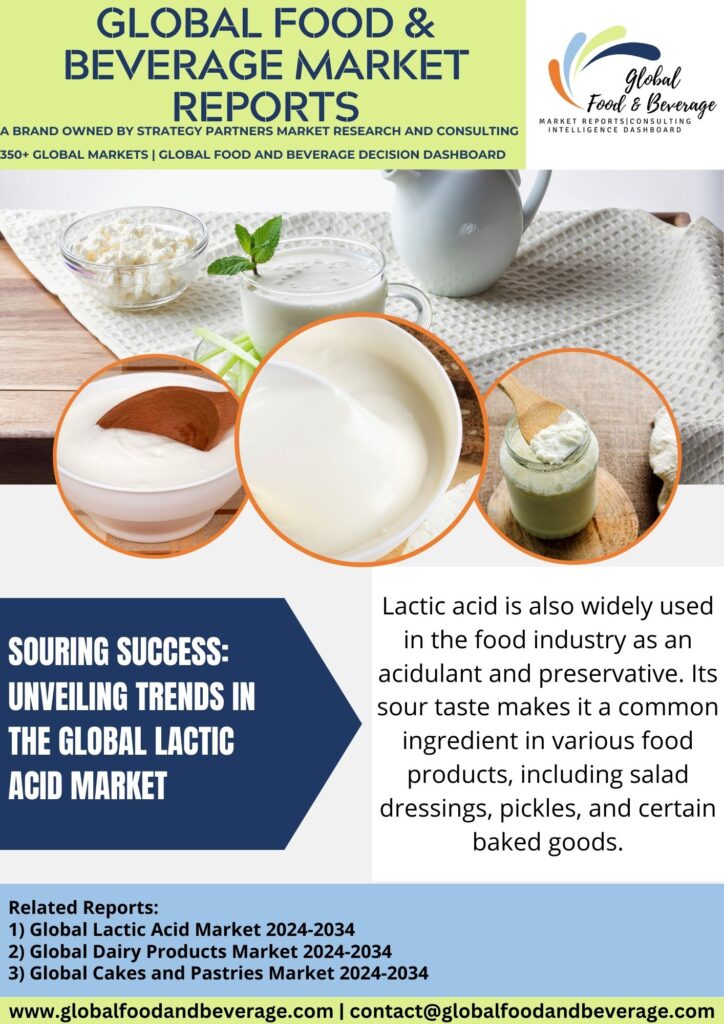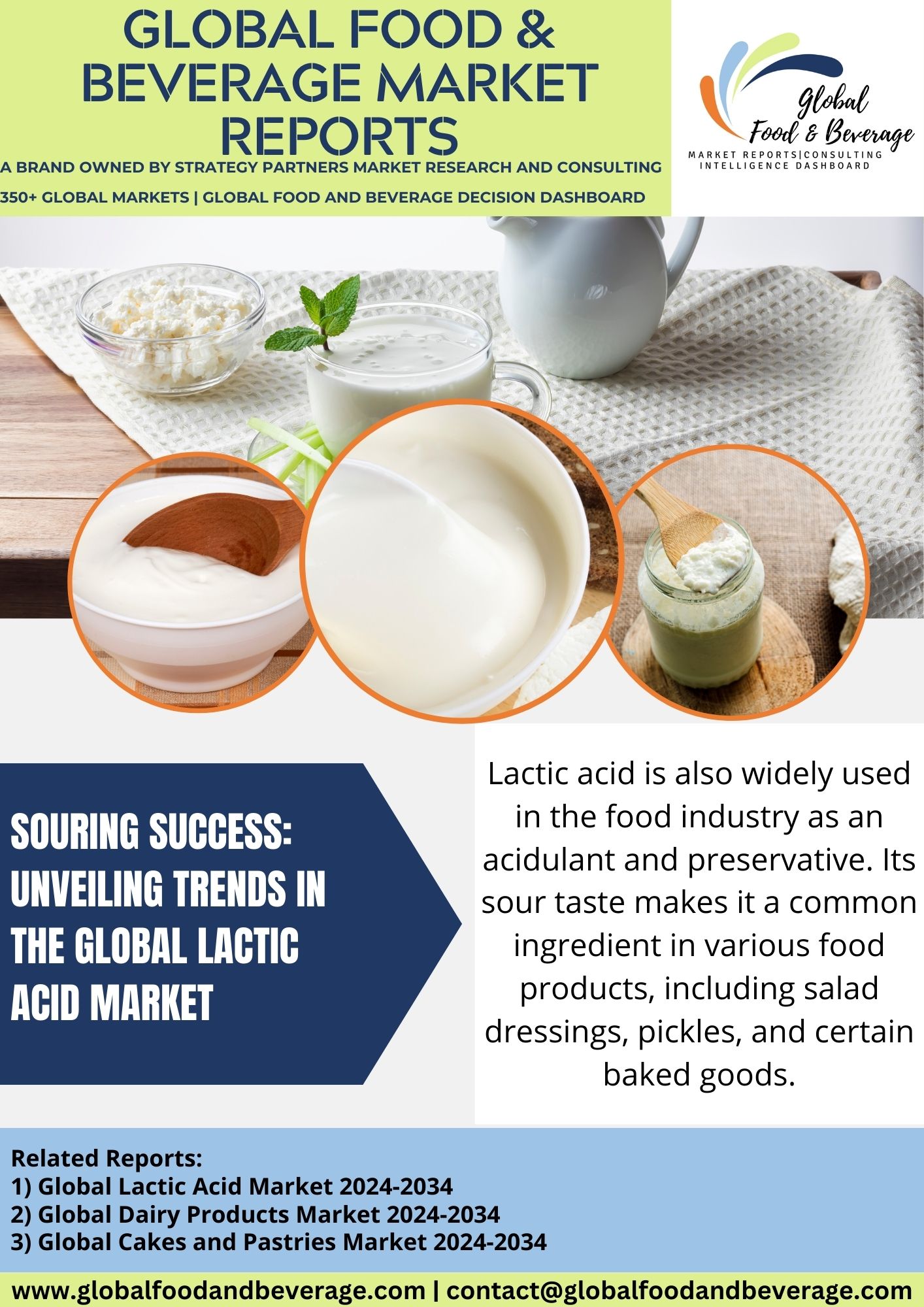Souring Success: Unveiling Trends in the Global Lactic Acid Market
Lactic acid, a versatile organic compound, plays a pivotal role in various biological processes, industries, and even contributes to the distinctive flavors of certain foods. Chemically known as 2-hydroxypropanoic acid, lactic acid is produced through the fermentation of sugars by lactic acid bacteria. This fermentation process occurs in various natural settings, such as the souring of milk, as well as in controlled environments for the production of fermented foods and beverages.
One of the most well-known applications of lactic acid is in the dairy industry. Lactic acid bacteria, such as Lactobacillus, convert lactose, the sugar present in milk, into lactic acid through fermentation. This process imparts a tangy flavor and contributes to the thickening and preservation of dairy products like yogurt and cheese. The controlled fermentation of milk with specific strains of bacteria is not only crucial for achieving the desired taste and texture but also enhances the shelf life and safety of these products.
Beyond the culinary realm, lactic acid has found applications in various industrial processes. Its biodegradable and eco-friendly nature makes it a valuable component in the production of bioplastics, offering an alternative to traditional petroleum-based plastics. Lactic acid-based polymers have garnered attention for their potential to reduce environmental impact and dependency on fossil fuels.

Lactic acid
Lactic acid also plays a key role in the field of medicine. In the human body, lactic acid is produced during anaerobic respiration, particularly during intense physical activity when oxygen supply to cells is insufficient. While excessive accumulation of lactic acid can lead to muscle fatigue and soreness, moderate levels serve as a crucial energy source during times of increased metabolic demand.
Moreover, lactic acid is utilized in the cosmetic and skincare industry for its exfoliating and moisturizing properties. Alpha hydroxy acids, including lactic acid, are commonly incorporated into skincare products to promote skin renewal, improve texture, and enhance hydration.
ADVANCEMENTS
The utilization of lactic acid showcase its versatility and applications in various industries, contributing to sustainability, innovation, and improved manufacturing processes. One significant breakthrough is the development of biobased lactic acid production. Traditional methods involved fermentation of sugars by bacteria, but advancements in biotechnology, such as metabolic engineering and fermentation optimization, enable the efficient production of lactic acid from renewable resources like corn, sugarcane, or lignocellulosic biomass. This shift towards biobased production aligns with sustainability goals and reduces dependence on fossil fuel-derived feedstocks.
Lactic acid polymers, also known as polylactic acid (PLA), have seen remarkable advancements. PLA is a biodegradable and bio-based polymer derived from lactic acid. Innovations in PLA processing technologies have improved its mechanical properties, making it a viable alternative to traditional petroleum-based plastics. This contributes to the reduction of environmental impacts and supports the development of more sustainable packaging materials.
The integration of lactic acid into the field of cosmetics and personal care is another notable advancement. Lactic acid, known for its exfoliating and moisturizing properties, is now widely used in skincare products. Its inclusion in formulations contributes to the development of effective and skin-friendly products, catering to the increasing consumer demand for natural and functional ingredients.
Advancements in food preservation involve the use of lactic acid and its salts as natural antimicrobial agents. Lactic acid inhibits the growth of spoilage microorganisms and pathogens, extending the shelf life of food products. This application aligns with the demand for clean-label and natural preservatives, addressing consumer preferences for minimally processed and safe foods.
CHALLENGES
Lactic acid, a versatile organic acid used in various industries, faces challenges related to production methods, market dynamics, regulatory compliance, and environmental sustainability. One significant challenge is the choice between chemical synthesis and fermentation for lactic acid production. While chemical methods are more established, fermentation using microorganisms such as bacteria or fungi is considered a greener alternative. However, optimizing fermentation processes for scalability and cost-effectiveness remains a challenge.
Market competition is intense, with lactic acid being used in applications ranging from food and pharmaceuticals to bioplastics. Successfully differentiating lactic acid products, addressing diverse industrial needs, and staying competitive demand continuous innovation in production methods, formulations, and marketing strategies.
Regulatory compliance can be complex, given the wide range of applications for lactic acid. Adhering to diverse regulations across industries, regions, or countries requires continuous diligence to ensure transparency and compliance with evolving standards.
Environmental sustainability is a growing concern in lactic acid production. While fermentation is considered more environmentally friendly than chemical synthesis, addressing issues such as waste management, resource use efficiency, and the overall environmental impact of large-scale production processes poses ongoing challenges.
Consumer education is vital, especially in industries where lactic acid is used as a food additive. Effectively communicating the safety, benefits, and uses of lactic acid is crucial for building consumer awareness and trust.
CONCLUSION
Lactic acid stands as a versatile and valuable compound, transcending its role in fermentation to become a cornerstone in various industries. From enhancing food preservation to contributing to skincare formulations, its applications continue to evolve. The industry’s commitment to sustainable production and innovative uses aligns with the growing demand for eco-friendly alternatives. As lactic acid gains prominence in diverse fields, from bioplastics to pharmaceuticals, the future promises continued exploration of its multifaceted potential. In this era of sustainability and scientific advancement, lactic acid emerges not just as a byproduct of fermentation but as a key player shaping the landscape of greener, healthier, and technologically advanced products.
